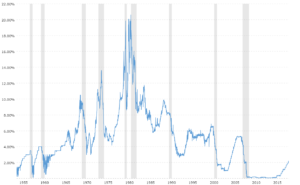Part two of a two-part series on interest rates and the federal debt.
Servicing the federal debt will cost U.S. taxpayers $479 billion this year, even though interest rates are near historic lows. What would happen if interest rates increased?
When the Federal Reserve Board voted last month to lower interest rates for the third time this year, the federal funds rate dropped to a range of just 1.75% to 2.00%. That’s half of the historical average of about 3½% (a range of 2% to 5%).
Double interest rates and, based on current spending, interest payments would zoom to nearly $1 trillion. In the late ’70s and early ’80s, interest rates soared and even exceeded 20%. If interest rates were to rise that high again, the cost of servicing the debt would potentially exceed the entire budget.
We are headed to a future we cannot afford, and our children and grandchildren will pay the price if we don’t address it. Yet politicians from both parties continue to ignore the problem. In fact, they are coming up with unrealistic new ways to spend trillions of dollars more.
Medicare for All has a projected price of $32.6 trillion over its first decade. The cost of forgiving student loan debt – if it’s limited to existing student loans – would be $1.6 trillion.
The price of implementing The Green New Deal, which would eliminate the use of fossil fuels, is incalculable, because much of the technology it would require doesn’t exist. The Green New Deal also promises plenty of free stuff, such as a guaranteed income, which you can receive even if you don’t want to work. The cost of a universal basic income (UBI) of $12,000 a year is estimated to be $3.8 trillion a year, which is 21% of U.S. gross domestic product (GDP) or 78% of tax revenue.
So the political solution to rising debt is to take advantage of low interest rates and keep spending. If politicians delay action long enough, it will be someone else’s problem.
But what will happen if no action is taken? When hundreds of billions or even trillions of dollars are needed to service the debt, that money isn’t being used productively. That money isn’t creating jobs in either the government or the private sector. Taxes will have to rise to pay off interest on the debt and that will leave less money available for business investment, which will lead to fewer jobs and a stagnant economy.
According to Peter Schiff, CEO of Euro Pacific Capital Inc., the Fed’s bond portfolio will continue to grow, and interest rates will stay low permanently. Then, when a recession comes, the Fed won’t be able to fight it with lower interest rates and Congress won’t be able to fight it with lower taxes, because the revenue will be needed to service the debt.
“Well, when the balance sheet is five-trillion, six-trillion, seven-trillion; when we’re back at zero; when we’re back in a recession,” according to Schiff, “nobody is going to believe it is temporary. Nobody is going to believe that the Fed has this under control, that they can reverse this policy. And the dollar is going to crash. And when the dollar crashes, it’s going to take the bond market with it and we’re going to have stagflation. We’re going to have a deep recession with rising interest rates and this whole thing is going to come imploding down.”
That may be alarmist, but clearly the issue needs to be addressed. The longer we wait to do something about our debt, the more difficult it will be to make meaningful changes.
A Global Problem
Growing debt isn’t just a problem for the U.S. government. It’s a problem for state and local governments. It’s a problem for consumers and corporations. And it’s a problem globally.
Since the financial crisis, government debt globally has nearly doubled, according to Fitch Ratings, and totaled $66 trillion at the end of last year. Debt now equals about 80% of gross domestic product (GDP) globally.
And while many countries have been spending well beyond their means, the U.S. has become a leading contributor to global debt.
“Debt in developed countries has remained fairly steady, around $50 trillion, since 2012,” CNBC reported, “though that’s not true of the U.S. Total public debt for the American government has jumped from $15.2 trillion to $21.9 trillion, or 44%, during the period, Treasury Department data show.”
The United States has become a global leader in accumulating debt. Now it’s time for the United States to become a global leader in addressing the problem.

